British and Irish have always a love-hate relationship and I'm not going to attempt to say who loves who and who hates whom - especially since we now have signs that some kind of sense may be stirring in Northern Ireland and the respective governments are talking like adults - as far as any politician can talk like an adult, that is! This scenario looks back in time to an earlier period of "unrest" when there were a few more governments involved but the politicians still behaved like children (sorry, kids) - Ed.]
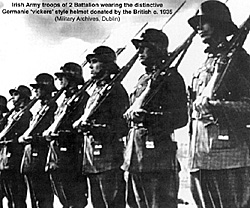 Irish Army troops wearing the distinctive Germanic 'vickers' style helmet donated by the British, c. 1935 (Military Archives, Dublin)
Irish Army troops wearing the distinctive Germanic 'vickers' style helmet donated by the British, c. 1935 (Military Archives, Dublin)
With the outbreak of the Second World War British interest in Ireland was rekindled. The need to offer protection to it's Atlantic convoys meant that Britain wanted to regain access to ports on the west coast of Ireland and ideally to get De Valera's Dublin government to offer the use of airfields also. But with the memory of the War of Independence fresh in Irish minds and partition an open sore, De Valera was determined to keep Eire out of the war. For the first year this was not a major problem, but then Churchill came to power in London. He immediately began sabre rattling, threatening to take control of the ports if Eire didn't hand them over.
Churchill initiated a press campaign against Eire's neutrality, attempting to justify an invasion. In January 1941 Churchill started an economic war with Eire, with the Royal Navy preventing the free flow of shipping to and from Ireland. The Irish army expected a British invasion throughout the Spring of '41. Then, in June the prime minister of Northern Ireland, Craigavon, called for an invasion of Eire and the placing of an Ulster Unionist general in control of the occupied state.
What protected Eire from Churchill was his dependence on America. A British governor in Dublin would have made it very difficult for Roosevelt to enter the war on Britain's side. De Valera's policy of neutrality had the support of a majority of Irish-Americans. Ironically, the closest Eire came to invasion was prior to D-Day, when American forces based in Northern Ireland feared for their security and ring-fenced Ireland. There was some justification in these fears since it is likely that information regarding the Dieppe and Arnhem operations found their way to Germany via its legation in Dublin.
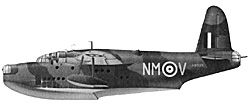 In March 1941, pursuing his policy of friendly neutrality, De Valera agreed to Britain's use of an air corridor from the R.A.F. flying boat base at Castle Archdale on Lough Erne, across Co. Donegal and on to the Atlantic. This increased the effective range of the British underlands and Catalinas. To cope with increasing numbers of shipwrecked mariners and downed airmen, permission was granted for an armed trawler to be based in Killybegs, Co.Donegal. In June 1941 the RN trawler Robert H. Hastie arrived in the fishing port. It had been stripped of it's
twelve pounders, left only with two machine guns. Whilst at sea it flew the red ensign, but not in port.
In March 1941, pursuing his policy of friendly neutrality, De Valera agreed to Britain's use of an air corridor from the R.A.F. flying boat base at Castle Archdale on Lough Erne, across Co. Donegal and on to the Atlantic. This increased the effective range of the British underlands and Catalinas. To cope with increasing numbers of shipwrecked mariners and downed airmen, permission was granted for an armed trawler to be based in Killybegs, Co.Donegal. In June 1941 the RN trawler Robert H. Hastie arrived in the fishing port. It had been stripped of it's
twelve pounders, left only with two machine guns. Whilst at sea it flew the red ensign, but not in port.
Donegal was an isolated corner of Eire. Sharing only a small border with the south, it had been cut off from its neighbouring Ulster counties. There was a large reservoir of anti-British feelings because of this partition. Low flying British aircraft could count upon becoming targets for the stone throwing youths of the Donegal mountains. From time to time local fishermen are known to have sold their catches to U-boats surfacing off the Donegal coast. Some locals, including General Montgomery's mother, would wave at the convoys as they sailed out of Derry along the Donegal coast. Others waited to hear the sound of shellfire and torpedoes as the convoys reached the horizon.
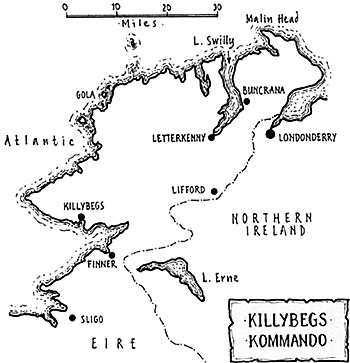 Its isolation meant that Donegal was not to be defended in the case of an invasion from Northern Ireland. Only 1,150 soldiers defended the county, 278 were based at the forts protecting Lough Swilly. The 17th infantry battalion was responsible for the rest of the county, with companies divided between Letterkenny, Buncrana, Malin Head, Killybegs and Finner camp.
Only the HQ company was mechanised.
Its isolation meant that Donegal was not to be defended in the case of an invasion from Northern Ireland. Only 1,150 soldiers defended the county, 278 were based at the forts protecting Lough Swilly. The 17th infantry battalion was responsible for the rest of the county, with companies divided between Letterkenny, Buncrana, Malin Head, Killybegs and Finner camp.
Only the HQ company was mechanised.
The battalion consisted of 881 all ranks, divided into an HQ company, a MG company (4 platoons with four Vickers HMG) and three rifle companies. Each rifle company comprised three rifle sections along with a light machine gun section with either Hotchkiss or Lewis guns. (Brens later in the war.) The riflemen carried .303 Lee Enfields. In addition, the battalion had two 81mm mortars and 18 Boyes anti-tank rifles.
To augment these forces were the civil police (Garda), with a partially armed Local Security Force to assist the police and an armed Local Defence Force to assist the army. Initially the LSF had a mix of sporting weapons, shotguns and ex-IRA weapons.
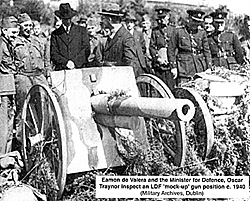 Eamon de Valera and the Minister for Defence, 0scar Traynor inspect an LDF 'mock-up' gun position c. 1940. (Military Archives, Dublin)
Eamon de Valera and the Minister for Defence, 0scar Traynor inspect an LDF 'mock-up' gun position c. 1940. (Military Archives, Dublin)
Large Photo LDF 'mock-up' gun position c. 1940. (79K)
One platoon of the LDF started the war with 18th century militia Brown Bess muskets and carbines. But soon they were issued with .300 Springfield rifles. In larger ports, port control duties were carried out by armed sailors, in smaller ports like Killybegs such duties fell to the LSF/LDF.
The nearest reserve force was a cycle squadron based in Sligo. The nearest armoured forces were over eighty miles away in Kildare. Against this small force the British had earmarked an entire division, the 61st, to invade Donegal.
In case of invasion the Irish had two divisions: the 1st division was to counter a German landing in the south, the 2nd division was to counter a British invasion from the north. General Hugo MacNeill was in command of the 2nd Division. His pro-German sentiments are well documented. It is probable that he discussed Anglo-Irish military co-operation during one of his many meetings with an SS officer in the Dublin legation. He was friendly with the leader of the Irish fascist movement, the Blueshirts. There is no doubt that the army and police were populated by Blueshirts. When war broke out, many ex-IRA veterans of the War of Independence and the Civil War joined up. The army planned to counter an invasion with a short holding action followed by a guerrilla war. Ideally, help would arrive from either Britain or Germany, depending on who invaded first.
The Germans had several plans to invade Ireland, mostly as a side show to an invasion of Britain seeing it as a way to draw off British troops, planes and ships. At a time when Northern Ireland was defended by Rolls Royce armoured cars of the North Irish Horse and a few Vickers light tanks of the Fife and Forfar yeomanry, the German airborne general Karl Student proposed a plan for a solely airborne invasion of Northern Ireland. But he was diverted to operations in the Mediterranean.
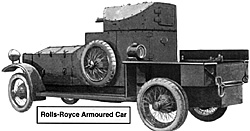 Much of the west coast was ruled too dangerous to attempt a seaborne landing on, and Donegal was
considered the worst of all. The Germans soon realised that the
voyage from France to Ireland was too long and too exposed to be worth the
risk. However as early as June 1940 the Germans began a misinformation
campaign, aimed at getting Britain to believe an invasion of Eire was
imminent and cause them to station extra troops and aircraft in Northern Ireland.
Much of the west coast was ruled too dangerous to attempt a seaborne landing on, and Donegal was
considered the worst of all. The Germans soon realised that the
voyage from France to Ireland was too long and too exposed to be worth the
risk. However as early as June 1940 the Germans began a misinformation
campaign, aimed at getting Britain to believe an invasion of Eire was
imminent and cause them to station extra troops and aircraft in Northern Ireland.
But what if the Germans had tried to provoke a British invasion of Eire? De Valera was so worried that sustained activity by the IRA would encourage a British invasion that he interned all suspected IRA members. But there were still gunmen at large. What if the Germans linked up with them in an attack on Britain? What follows is a hypothetical situation, but based on fact.
To Killybegs Kommando Scenario
Further Reading
FISK, ROBERT "IN TIME OF WAR""-,
(DUBLIN 1985)
FOSTER, IAIN "A NORTH-WEST PASSAGE" (AN COSANTOIR, APRIL
1994)
VARIOUS AUTHORS "THE EMERGENCY 1939-45" (THE IRISH SWORD VOL.XIX Nos. 75&76.)
UNIFORMS: IRISH DEFENCE FORCES HANDBOOKS 1982 & 1988.
KIDD, R.S. & FOSTEN, BRYAN "FIANNA FAIL" in Military Modelling, October 1984.
Vehicles
MARTIN, KARL "IRISH ARMY ARMOURED CARS" (DUBLIN 1983)
McCARTHY, DENIS J. "THE IRISH LEYLANDS" In Military Modelling, February 1988
Back to Battlefields Vol. 1 Issue 7 Table of Contents
Back to Battlefields List of Issues
Back to Master Magazine List
© Copyright 1999 by Partizan Press.
This article appears in MagWeb (Magazine Web) on the Internet World Wide Web.
Other military history articles and gaming articles are available at http://www.magweb.com